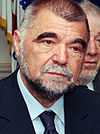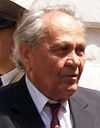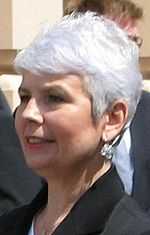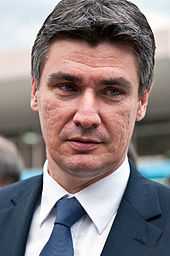Prime Minister of Croatia
| President of the Government of Croatia
Predsjednik Vlade Republike Hrvatske | |
|---|---|
|
Coat of Arms of Croatia | |
| Appointer | President of the Republic |
| Inaugural holder | Stjepan Mesić |
| Formation | 30 May 1990 |
| Website | www.vlada.hr |
 |
| This article is part of a series on the politics and government of Croatia |
| Constitution |
|
Legislative
|
|
|
|
Recent elections
Recent referenda |
| Foreign relations |
|
Politics portal |
The Prime Minister of Croatia, officially the President of the Government of the Republic of Croatia (Croatian: Predsjednik Vlade Republike Hrvatske), is Croatia's head of government, and is the de facto most powerful and influential state officeholder in the Croatian system of government. Following the first-time establishment of the office in 1945, the 1990-2001 semi-presidential period is the only exception where the President of Croatia held de facto authority. In the formal Croatian order of precedence, however, the position of prime minister is the third highest state office, after the President of the Republic and the Speaker of the Parliament.
The Constitution of Croatia prescribes that the Parliament "supervises" the Government (Article 81) and that the President of the Republic "ensures the regular and balanced functioning and stability of government" (as a whole; Article 94), while the Government is introduced in Article 108.[1] Since 2000, the prime minister has had various added constitutional powers and is mentioned before the Government itself in the text of the Constitution, in Articles 87, 97, 99, 100, 101, 103, 104.[1] The current Prime Minister of Croatia is Zoran Milanović. The Government of Croatia meets in Banski dvori, a historical building located on the west side of St. Mark's Square in Zagreb.
Name
The official name of the office, literally translated, is "President of the Government" (Predsjednik Vlade), rather than "Prime Minister" (Prvi Ministar). When the office was first established in 1945, the name "President of the Government" was introduced. The name of the office was changed 8 years later with the Yugoslav constitutional reforms of 1953, into "President of the Executive Council" (Predsjednik Izvršnog Vijeća). After another round of constitutional reforms in 1990, the office was renamed back to its original 1945-1953 title of "President of the Government". For all periods, however, the term "Prime Minister" is ubiquitous in English-language usage.
History
The first Prime Minister of Croatia was Vladimir Bakarić, who assumed the position on 14 April 1945. The position was then, as it is today, the most powerful public office in the state (the only exception in that regard is the 1990-2000 semi-presidential period, during which the President was the most significant figure). In post-World War II Croatia, which was at the time a constituent republic of Yugoslavia, a single-party system was in place. During this time there were twelve heads of government, all from the ranks of the Communist Party of Yugoslavia (KPJ), which was reformed and renamed into the League of Communists of Yugoslavia (SKJ) in 1952. The federal party was organized into six sub-organizations - the republic parties, one for each of the six federal republics. Croatian politicians and prime ministers of the period were members of the League of Communists of Yugoslavia through their membership in the League of Communists of Croatia (SKH), the Croatian part of the federal party (as was respectively the case with all Yugoslav politicians). The office remained the central post of Croatian politics in spite of the institution of a collective Presidency in 1974 (previously the mostly-nominal function of the head of state belonged to the Speaker of the Croatian Parliament, the Sabor).
After the constitutional amendments that allowed for multi-party elections in Croatia, the Parliament enacted amendments to the constitution (25 July) which eliminated socialist references and adopted new national symbols. The newly elected tricameral Parliament proceeded to change the Constitution of Croatia, and on 22 December 1990, this so-called "Christmas Constitution" fundamentally defined the Republic of Croatia and its governmental structure. Since the 1990 constitution Croatia was a semi-presidential republic, which meant the President of Croatia had broad executive powers, including naming the Prime Minister and dissolving the government. During this period, lasting until 2000/2001, Croatia had nine prime ministers. The first Prime Minister of Croatia since the 1990 constitutional reforms was Stjepan Mesić, assuming office on 30 May 1990.[2][3]
Croatia proclaimed independence from Yugoslavia on 25 June 1991 following the May 1991 independence referendum. However, the country then signed the July 1991 Brijuni Agreement in which it agreed to postpone the formal declaration of independence for three months. Meanwhile, the Croatian War of Independence ensued, and Franjo Gregurić was appointed to lead a Government of National Unity. In October the same year, Croatia formally declared independence, with Gregurić continuing on as the first prime minister of Croatia after the secession from Yugoslavia.
Following the January 2000 general election the winning centre-left coalition led by the Social Democratic Party amended the Constitution and effectively stripped the President of most of his executive powers, strengthening the role of the Parliament and the Prime Minister, turning Croatia into a parliamentary republic. The Prime Minister again (as before 1990) became the foremost post in Croatian politics.
List
League of Communists of Yugoslavia League of Communists of Croatia Croatian Democratic Union Social Democratic Party
| No. | Name (Born-Died) |
Portrait | Term of Office | Political party | Election(s) | Cabinet | ||
|---|---|---|---|---|---|---|---|---|
| Took Office | Left Office | Duration | ||||||
| N/A | Pavle Gregorić[4] (1892-1989) |
 |
7 March 1945 | 14 April 1945 | 39 days | Communist Party of Yugoslavia | — | Gregorić |
| 1 | Vladimir Bakarić (1912–1983) |
.jpg) |
14 April 1945 | December 1953 | 8 years, 7 months, 18 days | Communist Party of Yugoslavia (party renamed in 1952) League of Communists of Yugoslavia (party renamed in 1952) |
— | Bakarić |
| 2 | Jakov Blažević (1912–1996) |
 |
December 1953 | July 1962 | 8 years, 7 months | League of Communists of Yugoslavia | — | Blažević |
| 3 | Zvonko Brkić (1912–1977) |
 |
July 1962 | June 1963 | 11 months | League of Communists of Yugoslavia | — | Brkić |
| 4 | Mika Špiljak (1916–2007) |
 |
June 1963 | May 1967 | 3 years, 11 months | League of Communists of Yugoslavia | — | Špiljak |
| 5 | Savka Dabčević-Kučar (1923–2009) |
 |
May 1967 | May 1969 | 2 years | League of Communists of Yugoslavia | — | Dabčević-Kučar |
| 6 | Dragutin Haramija (1923–2012) |
 |
May 1969 | December 1971 | 2 years, 7 months | League of Communists of Yugoslavia | — | Haramija |
| 7 | Ivo Perišin (1925–2008) |
 |
December 1971 | April 1974 | 2 years, 4 months | League of Communists of Yugoslavia | — | Perišin |
| 8 | Jakov Sirotković (1922–2002) |
 |
April 1974 | 9 May 1978 | 4 years, 1 month | League of Communists of Yugoslavia | — | Sirotković |
| 9 | Petar Fleković (1932–) |
 |
9 May 1978 | July 1980 | 2 years, 2 months | League of Communists of Yugoslavia | — | Fleković |
| 10 | Ante Marković (1924–2011) |
 |
July 1980 | November 1985 | 5 years, 4 months | League of Communists of Yugoslavia | — | Marković |
| 11 | Ema Derossi-Bjelajac (1926–) |
 |
November 1985 | 10 May 1986 | 6 months | League of Communists of Yugoslavia | — | Derossi-Bjelajac |
| 12 | Antun Milović (1934–2008) |
 |
10 May 1986 | 30 May 1990 | 4 years, 21 days | League of Communists of Yugoslavia (until January 1990) League of Communists of Croatia (from January 1990) |
— | Milović |
| Following the 1990 parliamentary election and constitutional reforms | ||||||||
| 1 (13) |
Stjepan Mesić (1934-) |
 |
30 May 1990 | 24 August 1990 | 86 days | Croatian Democratic Union | 1990 | Mesić |
| 2 (14) |
Josip Manolić (1920–) |
 |
24 August 1990 | 17 July 1991 | 327 days | Croatian Democratic Union | — | Manolić |
| 3 (15) |
Franjo Gregurić (1939–) |
 |
17 July 1991 | 12 August 1992 | 1 year, 26 days | Croatian Democratic Union | — | Gregurić |
| 4 (16) |
Hrvoje Šarinić (1935–) |
 |
12 August 1992 | 3 April 1993 | 1 year, 234 days | Croatian Democratic Union | 1992 | Šarinić |
| 5 (17) |
Nikica Valentić (1950–) |
 |
3 April 1993 | 7 November 1995 | 2 years, 218 days | Croatian Democratic Union | — | Valentić |
| 6 (18) |
Zlatko Mateša (1949–) |
 |
7 November 1995 | 27 January 2000 | 4 years, 81 days | Croatian Democratic Union | 1995 | Mateša |
| 7 (19) |
Ivica Račan (1944–2007) |
 |
27 January 2000 | 30 July 2002 | 3 years, 330 days | Social Democratic Party | 2000[5] | Račan I |
| 30 July 2002 | 23 December 2003 | Račan II | ||||||
| 8 (20) |
Ivo Sanader (1953–) |
 |
23 December 2003 | 12 January 2008 | 5 years, 195 days | Croatian Democratic Union | 2003 | Sanader I |
| 12 January 2008 | 6 July 2009 | 2007 | Sanader II | |||||
| 9 (21) |
Jadranka Kosor (1953–) |
 |
6 July 2009 | 23 December 2011 | 2 years, 170 days | Croatian Democratic Union | — | Kosor |
| 10 (22) |
Zoran Milanović (1966–) |
 |
23 December 2011 | Incumbent | 3 years, 127 days | Social Democratic Party | 2011 | Milanović |
Statistics
| # | Prime Minister | Date of birth | Age at ascension (first term) |
Time in office (total) |
Age at retirement (last term) |
Date of death | Longevity |
|---|---|---|---|---|---|---|---|
| 1 | Stjepan Mesić | December 24, 1934 | 55 years, 157 days | 0 years, 86 days | 55 years, 243 days | Living | 80 years, 126 days (Living) |
| 2 | Josip Manolić | March 22, 1920 | 70 years, 155 days | 0 years, 327 days | 71 years, 117 days | Living | 95 years, 38 days (Living) |
| 3 | Franjo Gregurić | October 12, 1939 | 51 years, 278 days | 1 year, 26 days | 52 years, 305 days | Living | 75 years, 199 days (Living) |
| 4 | Hrvoje Šarinić | February 17, 1935 | 57 years, 177 days | 0 years, 234 days | 58 years, 45 days | Living | 80 years, 71 days (Living) |
| 5 | Nikica Valentić | November 24, 1950 | 42 years, 130 days | 2 years, 218 days | 44 years, 348 days | Living | 64 years, 156 days (Living) |
| 6 | Zlatko Mateša | June 17, 1949 | 46 years, 143 days | 4 years, 81 days | 50 years, 224 days | Living | 65 years, 316 days (Living) |
| 7 | Ivica Račan | February 24, 1944 | 55 years, 337 days | 3 years, 330 days | 59 years, 302 days | April 29, 2007 | 63 years, 64 days |
| 8 | Ivo Sanader | June 8, 1953 | 50 years, 198 days | 5 years, 195 days | 56 years, 28 days | Living | 61 years, 325 days (Living) |
| 9 | Jadranka Kosor | July 1, 1953 | 56 years, 5 days | 2 years, 170 days | 58 years, 175 days | Living | 61 years, 302 days (Living) |
| 10 | Zoran Milanović | October 30, 1966 | 45 years, 54 days | 3 years, 127 days (Ongoing) | Incumbent | Living | 48 years, 181 days (Living) |
See also
- List of Croatian Governments
- President of Croatia
- Speaker of the Croatian Parliament
- Secretary of the League of Communists of Croatia
- Politics of Croatia
- List of heads of state of Yugoslavia
- Prime Minister of Yugoslavia
References
- ↑ 1.0 1.1 "The Constitution of the Republic of Croatia (consolidated text)". Croatian Parliament. Retrieved 2011-02-16.
- ↑ "Chronology of Croatian governments" (in Croatian). Croatian Information-Documentation Referral Agency. Retrieved 2011-05-13.
- ↑ "Prethodne Vlade RH" [Former Governments of the Republic of Croatia] (in Croatian). Croatian Government. Retrieved 2010-12-13.
- ↑ De facto prime minister. Pavle Gregorić was Minister for Croatia, temporary representative for Croatia in the Yugoslav federal government.
- ↑ After the changes to the Constitution of the Republic of Croatia the country moved from a semi-presidential system to a parliamentary system, making the Prime Minister the most powerful office in the country.
| ||||||||||||||||||||||||||||||||||||||||||
| ||||||||||||||
| ||||||||||||||